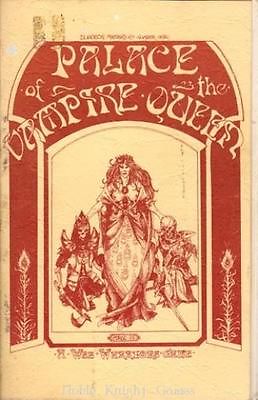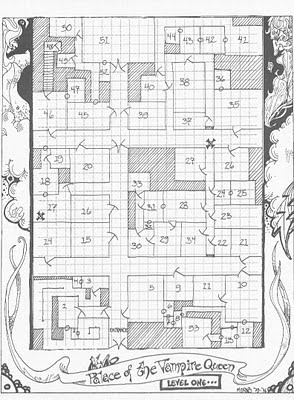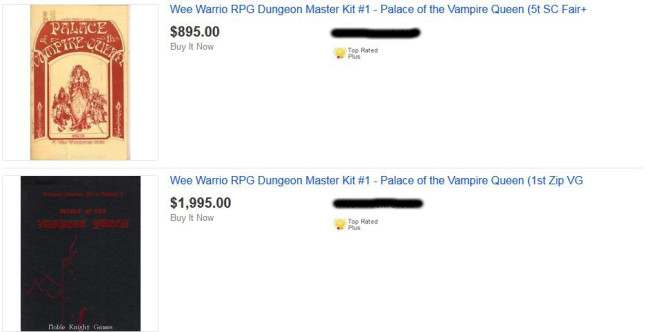How much for that Palace of the Vampire Queen?
Posted by Rampant Coyote on September 14, 2015
 Until this weekend, I’d never heard of the Palace of the Vampire Queen. It was arguably the first official Dungeons & Dragons module ever published… if you consider the Temple of the Frog (from the Blackmoor supplement) to be more of a scenario than a full-fledged adventure module. Here I was thinking Judge’s Guild had the lock on that, but no. A tiny company called Wee Warriors made supplements for the game, which were in turn published by TSR (owners of the D&D license).
Until this weekend, I’d never heard of the Palace of the Vampire Queen. It was arguably the first official Dungeons & Dragons module ever published… if you consider the Temple of the Frog (from the Blackmoor supplement) to be more of a scenario than a full-fledged adventure module. Here I was thinking Judge’s Guild had the lock on that, but no. A tiny company called Wee Warriors made supplements for the game, which were in turn published by TSR (owners of the D&D license).
The module was, in the words of one reviewer, “sketchy.” Your $4.50 got you a stapled booklet with ten maps – five keyed, five unkeyed duplicates – with effectively a spreadsheet of encounters. The spreadsheet had very little information beyond what monsters were encountered and what treasure they held. Dungeon Masters were intended to take the bare bones of the story and the provided encounters and let the players’ story evolve.
Which is actually a pretty cool concept when you think of it. But it might be a bit to ask of less experienced gamers and game-masters, as that’s often the part they need the most help with. Here’s an example of five rooms worth of keyed encounters, taken from RetroRoleplaying.com:
| Room | Creatures Encountered | Max Hits | Contents of Room |
| 1 | 3 Goblins | 4 3 3 | 17 GP on Goblins |
| 2 | none | 6 bags – each bag contains rations for 1 for 1 week in dungeon, but 1 bag is poisoned | |
| 3 | 3 Goblins | 4 4 1 | Armory, 5 swords, 3 shields, 2 daggers. All non-magical. |
| 4 | none | Chest with poison lock, 1,000 CP in chest | |
| 5 | 4 Goblins 2 sleeping, 2 on guard |
5 2 3 3 | Empty. 30 CP, 10 GP on Goblins |
This is slightly more interesting than the results you’d get from running a random dungeon generator like Donjon. But only slightly. And even that’s arguable.
 The maps were nicely done, but still resembled the kind of thing anyone would do with graph paper and pencil, with a bit of higher-quality embellishment. But recognize that this was circa 1975, when things were still extremely local, low-tech, and really more of a hobbyist industry than anything else. And really, as far as maps are concerned, a game master really only needs three things:
The maps were nicely done, but still resembled the kind of thing anyone would do with graph paper and pencil, with a bit of higher-quality embellishment. But recognize that this was circa 1975, when things were still extremely local, low-tech, and really more of a hobbyist industry than anything else. And really, as far as maps are concerned, a game master really only needs three things:
- It needs to be clear and easy-to-read
- It should be interesting for the players to navigate and explore
- It should be internally consistent and logical based on whatever laws of reality it is invoking. In other words, no defying major laws of physics or geometry without a cool reason.
- It should actually save the DM some work.
Without actually being able to read through the whole module, I can’t vouch for all of the details, but it sounds good.
So back in 1976, this thing had a cover price of around $4.50. Multiply that by three or so for modern US dollars, and it’s around $15. Yikes. Yeah, I’d expect a little bit more for my money in today’s world.
But as it is a less well-known piece of Role-Playing Game nostalgia, how much would an original copy of this supplement (called a “Dungeon Master’s Kit” at the time) set me back?
A little bit more than its original cover price:
*Coughcoughwheeze* Yeah, I expected it to be outside of my discretionary budget, but this is about 10x my best guess.
There is a more recent reprint and update available that’s a bit more within a curious hobbyist’s price range, but still… Not a bad mark-up. I’m just amazed that it took me this long to learn about it.
UPDATE: D’oh. Demoted the queen to a princess. It was late, and I think I conflated the title with that of another early (TSR-produced) module, Palace of the Silver Princess.
Filed Under: Dice & Paper - Comments: Comments are off for this article
